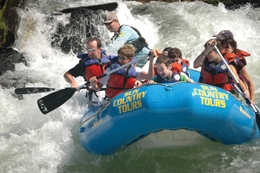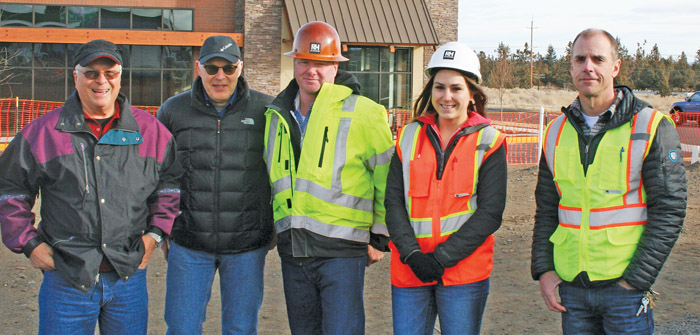
Word around the Pacific Northwest this year is that the massive mountain snow pack, combined with an extra-cool spring, is contributing to a robust season for river guides and rafting tour companies.
Local river guides say that’s not necessarily true for Central Oregon rafting companies because water levels on the Deschutes and Rogue rivers, the most popular destinations for splashing down the rapids on a hot summer day, are dam controlled, meaning this year’s massive snow pack is not affecting water levels as it is on many other rivers.
“This year, the reservoirs are full and they are releasing more water, which is translating into a better water year, for sure, but it’s not like we’re seeing a drastic difference where a normally class three rapids is now a class six (event) on the river that is too dangerous to run,” said Brian Sykes, general manager and owner of Bend-based Ouzel Outfitters, which began operations here in 1978. “Up until a about a week ago, we had almost no bookings for local day trips, but last week (June 25) reservations for day trips pretty much exploded. We’re hoping this will continue and that people just postponed their plans and are deciding to go now.”
Sykes said forward bookings for long, vacation-length trips and weekend jaunts – any trip where people have to plan ahead of time – have been solid, and this is where Ouzel Outfitters is experiencing a boon thanks to the snow pack.
“For instance, on the Owyhee River, where in 2007 we had to cancel all of our trips due to a lack of water, we are running seven weeks worth of trips this year, and that’s only possible because of the higher-than-normal snow pack,” Sykes said. “In a typical year we will only run about four of those five-day trips before the water level drops too far to run.”
In another example, the John Day River was too low to run last year, but for the 2008 season Ouzel Outfitters is planning trips through the first week of July, Sykes said, sending out as many as 34 guides on the water at any given time.
“It’s going to be close this July, as far as being able to make those trips, but at this time last year we didn’t have anything at all planned for July,” he said.
John Cramp, general manager of Sun Country Raft Tours, which is also celebrating its 30th year in business, agrees with Sykes’ assertion that 2008 is a strange booking year.
“I’m not sure whether it’s due to the negative economic news or to high gas prices everywhere, but last week reservations for local trips finally started to increase, and they are doing so rapidly,” Cramp said. “Our business was down a bit in May, but that’s also because it was 58 degrees and rainy, and when it is 58 degrees and rainy people don’t want to go out and get into the water.”
So far this year, overall bookings for Sun Country Raft Tours are up 11 percent compared to this period in 2006, and 5 percent ahead of the pace for 2004. Cramp said it is often difficult to accurately project revenues in the middle of the rafting season because customers tend to book a trip the week they want to head down the river. Customer bookings can change on a whim, too.
“Business will fall off dramatically if Mother Nature intervenes, like say there is a forest fire in the area,” Cramp said. “But we are cautiously optimistic that this is going to be a good year.”
Dozens of media reports about the 2008 white-water rafting season – in everything from The Oregonian to radio’s NPR to USA Today – claim business is booming across the industry. In fact, rafting companies throughout the Pacific Northwest supposedly are experiencing the best water levels in a decade, said David Brown of America Outdoors, a Knoxville, Tenn.-based trade association for outdoor outfitters.
“This year’s prime conditions notwithstanding, record gas prices and a slowing economy have translated to slower bookings for some outfitters, particularly in areas far from a metropolitan area or major tourist destination,” Brown said.
Cramp said that locally, an increase in customers has more to do with perception versus reality.
“The reality is there is always good water and good flows in Central Oregon, but the information out there about abundant snow and having higher snow packs is driving more interest, and because of that we are finally starting to see strong bookings,” Cramp said. “The truth about water levels here is the hotter and dryer we get the more water they (release from the dams). In drought year, they keep all that water in the reservoirs, which leads to low water levels on the Deschutes and the Rogue, but that’s definitely not the case this year. A little bit higher flow at this time of the year means higher water in a fun sense, not in scary sense.”
Rafting aficionados who want to explore rivers outside of Central Oregon certainly have plenty of choices. In 1968, President Lyndon Johnson signed the Wild and Scenic Rivers Act to safeguard the special character of the nation’s rivers.
According to the U.S. Fish and Wildlife Service, Oregon has 46 wild and scenic rivers, more than any other state, covering 1,743 miles. Alaska comes in second, with 25 wild and scenic rivers, or 3,210 miles. And there is a bill floundering in Congress called the Mount Hood Wilderness Act that would add another 11 rivers to Oregon’s list.
“No matter where you decide to go river rafting, it’s important for everybody to make sure they wear a life jacket any time they are on the river,” Cramp said.




